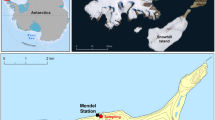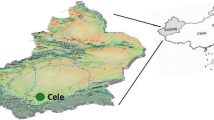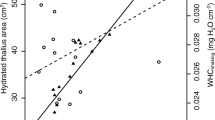Abstract
This study aims to assess the photoprotective potential of desiccation-induced curling in the light-susceptible old forest lichen Lobaria pulmonaria by using chlorophyll fluorescence imaging. Naturally curled thalli showed less photoinhibition-induced limitations in primary processes of photosynthesis than artificially flattened specimens during exposures to 450 μmol m−2 s−1 in the laboratory after both 12- (medium dose treatment) and 62-h duration (high dose treatment). Thallus areas shaded by curled lobes during light exposure showed unchanged values of measured chlorophyll fluorescence parameters (F V/F M, ΦPS II), whereas non-shaded parts of curled thalli, as well as the mean for the entire flattened thalli, showed photoinhibitory limitation after light treatments. Furthermore, the chlorophyll fluorescence imaging showed that the typical small-scale reticulated ridges on the upper side of L. pulmonaria caused a spatial, small-scale reduction in damage due to minor shading. Severe dry-state photoinhibition readily occurred in flattened and light-treated L. pulmonaria, although the mechanisms for such damage in a desiccated and inactive stage are not well known. Natural curling is one strategy to reduce the chance for serious photoinhibition in desiccated L. pulmonaria thalli during high light exposures.


Similar content being viewed by others
Abbreviations
- Chl:
-
Chlorophyll
- HD:
-
High light dose
- MD:
-
Medium light dose
- PS II:
-
Photosystem II
- ΦPS II :
-
Quantum yield of photochemical reactions in photosystem II
References
Alpert P, Oliver MJ (2002) Drying without dying. In: Black M, Pritchard HW (eds) Desiccation and survival in plants: drying without dying. CAB International, pp 3–43
Barták M, Hájek J, Gloser J (2000) Heterogeneity of chlorophyll fluorescence over thalli of several foliose macrolichens exposed to adverse environmental factors: interspecific differences as related to thallus hydration and high irradiance. Photosynthetica 38:531–537
Barták M, Vráblíková H, Hájek J (2003) Sensitivity of photosystem 2 of Antarctic lichens to high irradiance stress: fluorometric study of fruticose (Usnea antarctica) and foliose (Umbilicaria decussata) species. Photosynthetica 41:497–504
Barták M, Hájek J, Vráblíková H, Dubová J (2004) High-light stress and photoprotection in Umbilicaria antarctica monitored by chlorophyll fluorescence imaging and changes in zeaxanthin and glutathione. Plant Biol 6:333–341
Bilger W, Rimke S, Schreiber U, Lange OL (1989) Inhibition of energy-transfer to photosystem II in lichens by dehydration: different properties of reversibility with green and blue-green phycobionts. J Plant Physiol 134:261–268
Bukhov NG, Govindachary S, Egorova EA, Carpentier R (2004) Recovery of photosystem I and II activities during re-hydration of lichen Hypogymnia physodes thalli. Planta 219:110–120
Dahlman L, Palmqvist K (2003) Growth in two foliose tripartite lichens, Nephroma arcticum and Peltigera aphthosa: empirical modelling of external vs internal factors. Funct Ecol 17:821–831
Demmig-Adams B, Adams WW III, Green TGA, Czygan FC, Lange OL (1990a) Differences in the susceptibility to light stress in two lichens forming phycosymbiodeme, one partner possessing and one lacking the xanthophyll cycle. Oecologia 84:451–456
Demmig-Adams B, Máguas C, Adams WW III, Meyer A, Kilian E, Lange OL (1990b) Effect of high light on the efficiency of photochemical energy conversion in a variety of lichen species with green and blue-green phycobionts. Planta 180:400–409
Ertl L (1951) Über die Lichtverhältnisse in Laubflechten. Planta 39:245–270
Farrant JM, Vander Willigen C, Loffell DA, Bartsch S, Whittaker A (2003) An investigation into the role of light during desiccation of three angiosperm resurrection plants. Plant Cell Environ 26:1275–1286
Gauslaa Y, Solhaug KA (1996) Differences in the susceptibility to light stress between epiphytic lichens of ancient and young boreal forest stands. Funct Ecol 10:344–354
Gauslaa Y, Solhaug KA (1999) High-light damage in air-dry thalli of the old forest lichen Lobaria pulmonaria—interactions of irradiance, exposure duration and high temperature. J Exp Bot 50:697–705
Gauslaa Y, Solhaug KA (2000) High-light-intensity damage to the foliose lichen Lobaria pulmonaria within a natural forest: the applicability of chlorophyll fluorescence methods. Lichenologist 32:271–289
Gauslaa Y, Solhaug KA (2001) Fungal melanins as a sun screen for symbiotic green algae in the lichen Lobaria pulmonaria. Oecologia 126:462–471
Gauslaa Y, Solhaug KA (2004) Photoinhibition in lichens depends on cortical characteristics and hydration. Lichenologist 36:133–143
Gauslaa Y, Lie M, Solhaug KA, Ohlson M (2006) Growth and ecophysiological acclimation of the foliose lichen Lobaria pulmonaria in forests with contrasting light climates. Oecologia 147:406–416
Genty B, Briantais J-M, Baker NR (1989) The relationship between quantum yield of photosynthetic electron transport and quenching of chlorophyll fluorescence. Biochim Biophys Acta 990:87–92
Heber U, Bilger W, Bligny R, Lange OL (2000) Photoreactions in two lichens, a poikilohydric moss and higher plants in relation to phototolerance of alpine plants: a comparison. Planta 211:770–780
Heber U, Bukhov NG, Shuvalov VA, Kobayashi Y, Lange OL (2001) Protection of the photosynthetic apparatus against damage by excessive illumination in homoiohydric leaves and poikilohydric mosses and lichens. J Exp Bot 52:1999–2006
Hestmark G (1997) Competitive behaviour of umbilicate lichens—an experimental approach. Oecologia 111:523–528
Jahns HM, Tuiz-Dubiel A, Blank L (1976) Hygroskopische Bewegungen der Sorale von Hypogymnia physodes. Herzogia 4:15–23
Lange OL, Kilian E, Ziegler H (1990) Photosynthese von Blattflechten mit hygroskopischen Thallusbewegungen bei Befeuchtung durch Wasserdampf oder mit flüssigem Wasser. Bibl Lichen 38:311–323
Lange OL, Leisner JMR, Bilger W (1999) Chlorophyll fluorescence characteristics of the cyanobacterial lichen Peltigera rufescens under field conditions. II. Diel and annual distribution of metabolic activity and possible mechanisms to avoid photoinhibition. Flora 194:413–430
Lebkuecher JG, Eickmeier WG (1992) Photoinhibition of photophosphorylation, adenosine-triphosphate content, and glyceraldehyde-3-phosphate dehydrogenase (NADP+) following high-irradiance desiccation of Selaginella lepidophylla. Can J Bot 70:205–211
Lebkuecher JG, Eickmeier WG (1993) Physiological benefits of stem curling for resurrection plants in the field. Ecology 74:1073–1080
Lumbsch HT, Kothe HW (1988) Anatomical features of Chondropsis semiviridis (Nyl.) Nyl. in relation to its vagrant habit. Lichenologist 20:25–29
Muslin EH, Homann PH (1992) Light as a hazard for the desiccation-resistant “resurrection” fern Polypodium polypodiodes L. Plant Cell Environ 15:81–89
Rogers RW (1971) Distribution of the lichen Chondropsis semiviridis in relation to its heat and drought resistance. New Phytol 70:1069–1077
Rogers RW (1977) Lichens of hot arid and semi-arid lands. In: Seaward MRD (ed) Lichen ecology. Academic, London, pp 211–252
Shuvalov VA, Heber U (2003) Photochemical reactions in dehydrated photosynthetic organisms, leaves, chloroplasts and photosystem II particles: reversible reduction of pheophytin and chlorophyll and oxidation of beta-carotene. Chem Phys 294:227–237
Sigfridsson B (1980) Some effects of humidity on the light reaction of photosynthesis in the lichens Cladonia implexa and Collema flaccidum. Physiol Plant 49:320–326
Solhaug KA, Gauslaa Y (1996) Protective role of parietin against high light in the lichen Xanthoria parietina. Oecologia 108:412–418
Solheim I, Engelsen O, Hosgood B, Andreoli G (2000) Measurement and modeling of the spectral and directional reflection properties of lichen and moss canopies. Remote Sens Environ 72:78–94
Valladares F, Sanchezhoyos A, Manriques E (1995) Diurnal changes in photosynthetic efficiency and carotenoid composition of the lichen Anaptychia ciliaris—effects of hydration and light-intensity. Bryologist 98:375–382
Vráblíková H, McEvoy M, Solhaug KA, Barták M, Gauslaa Y (2006) Annual variation in photoacclimation and photoprotection of the photobiont in the foliose lichen Xanthoria parietina. J Photochem Photobiol B Biol 83:151–162
Acknowledgements
The research was supported by the project No. 522/03/0754 provided by the Grant Agency of the Czech Republic.
Author information
Authors and Affiliations
Corresponding author
Additional information
Communicated by Otto Lange
Rights and permissions
About this article
Cite this article
Barták, M., Solhaug, K.A., Vráblíková, H. et al. Curling during desiccation protects the foliose lichen Lobaria pulmonaria against photoinhibition. Oecologia 149, 553–560 (2006). https://doi.org/10.1007/s00442-006-0476-2
Received:
Accepted:
Published:
Issue Date:
DOI: https://doi.org/10.1007/s00442-006-0476-2




